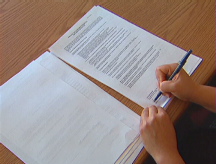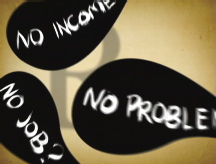Fed's war against shady home loans
In a nod to consumer advocates, regulators require lenders to evaluate subprime borrowers' ability to pay while banning most prepayment penalties.
| 30 yr fixed | 3.80% |
| 15 yr fixed | 3.20% |
| 5/1 ARM | 3.84% |
| 30 yr refi | 3.82% |
| 15 yr refi | 3.20% |
NEW YORK (CNNMoney.com) -- The Federal Reserve unanimously approved new mortgage lending rules Monday in a crackdown on shady practices - particularly those involving subprime loans made to borrowers with weak credit.
The agency made several substantial revisions to the proposed regulations it unveiled in December. Many of the changes acknowledged consumer advocates' concerns that the rules still contained too many loopholes that would allow shady lending practices to continue.
But the Fed also made some concessions to industry executives, who feared increasing oversight would lead to less lending.
The new rules will apply to all mortgage lenders, not just those supervised and examined by the Fed. All but one requirement will take effect Oct. 1, 2009. However, board members said they will continue to work on further oversight of the mortgage industry.
"The proposed final rules are intended to protect consumers from unfair or deceptive acts and practices in mortgage lending, while keeping credit available to qualified borrowers and supporting sustainable homeownership," said Fed Chairman Ben Bernanke. "Besides offering broader protection for consumers, a uniform set of rules will level the playing field for lenders and increase competition in the mortgage market, to the ultimate benefit of borrowers."
The proposals won't help the millions of homeowners who've already fallen behind in their mortgages, but the Fed is aiming to prevent another such crisis by tightening lending standards, particularly for subprime mortgages.
Many critics have charged that under former Fed Chairman Alan Greenspan, there were few restraints during the real estate boom. They say the agency should have flexed its muscles several years ago, clamping down on unscrupulous lenders and protecting borrowers.
Consumer advocates said they were pleased with the changes, but stressed that the Fed's action is just one in a series of steps needed to better protect borrowers from shady lenders. Industry executives, meanwhile, applauded the Fed for attempting to protect consumers while keeping in mind the need for low-cost mortgage loans.
The rules
The new rules governing "higher-priced," or subprime, loans will:
- Prohibit creditors from extending credit without regard to a consumer's ability to repay the loan from income and assets other than the home's value. The lender complies, in part, by assessing repayment ability based on the highest scheduled payment in the first seven years of the loan.
- Require creditors to verify income and assets they rely upon to determine repayment ability
- Ban any prepayment penalty if the payment can change in the initial four years. For other higher-priced loans, a prepayment penalty period cannot last for more than two years.
- Require creditors to establish escrow account for property taxes and homeowner's insurance. This rule will be phased in during 2010.
The Fed changed the definition of higher-priced loans to first mortgages with rates at least 1.5 percentage points above the average mortgage rate published by Freddie Mac. Also, second mortgages with rates at least 3.5 percentage points above the Freddie Mac rate will fall into this category.
With this change, the Fed is hoping to address industry complaints that the previous definition would capture non-subprime loans as well.
Additional rules will apply to all mortgages, regardless of rate.
- Creditors and mortgage brokers cannot coerce a real estate appraiser to misstate a home's value.
- Companies that service mortgage loans are prohibited from engaging in certain practices, such as pyramiding late fees. Also, they must credit consumers' loan payments as of the date of receipt and provide a payoff statement within a reasonable time of request.
- Creditors must provide a good faith estimate of the loan costs, including a schedule of payments, within three days after a consumer applies for any mortgage loan, including home improvement loans or refinancings. Currently, these estimates are only required for home-purchase loans. Consumers cannot be charged any fee until after they receive the early disclosures, except a reasonable fee for obtaining the consumer's credit history.
- In advertisements, companies must include additional information about rates, monthly payments and loan features. The rule also bans seven deceptive practices, such as saying a rate is fixed when it can change.
In a nod to the brokerage industry, the Fed withdrew a proposal requiring additional disclosure of the "yield-spread premium," which allows banks to pay brokers for steering homeowners into higher-priced loans. After testing consumers, the agency found that the rule would likely not be effective. But the Fed said it would continue reviewing the issue.
Advocates for consumers and industry generally pleased
Both consumer advocates and industry executives put a full-court press on the Fed in recent months, trying to get the agency to revise its proposed rules. More than 4,500 comments were filed since the agency announced its plan in late December.
After reviewing the final rules, advocates said they felt the changes did provide additional protections for the consumers. In particular, it's important that the Fed eliminated the requirement that borrowers prove lenders engaged in a "pattern or practice" of originating unaffordable loans since that's very hard to do, said Brenda Muniz, legislative director of Acorn, a housing advocacy group.
Still, the Fed could have done better by completely banning prepayment penalties, as several states have done, said Deborah Goldstein, executive vice president of the Center for Responsible Lending, a consumer rights organization. She noted that people in subprime fixed-rate loans are still subject to hefty fees if they try to refinance their loans within two years.
Also, some advocates wondered why the rules won't take effect for 15 months, and why subprime borrowers can opt out of escrowing their property taxes and homeowner's insurance after the first year.
"It's the first step toward better protecting consumers in the mortgage market, but not the last step," said Jim Carr, chief operating officer of the National Community Reinvestment Coalition, an advocacy group.
Industry executives, meanwhile, endorsed the changes overall, but said there still may be some areas of concern in the 419-page document. For instance, the Mortgage Bankers Association said it plans to ask its members about the elimination of the "pattern or practice" rule.
Still, the new rules will help consumers, without placing such a burden on lenders that they will have to curtail credit, industry insiders said.
"This is just the right amount of regulation," said Marc Savitt, president of the National Association of Mortgage Brokers. ![]()





